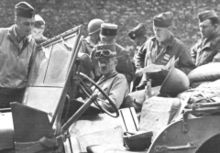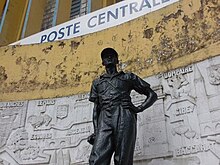Jacques-Philippe Leclerc de Hauteclocque
Jacques-Philippe Leclerc de Hauteclocque (born Philippe François Marie de Hauteclocque ; born November 22, 1902 in Belloy-Saint-Léonard , Département Somme ; † November 28, 1947 near Colomb-Béchar , today Algeria ) was a French major general in Second world war . He was posthumously appointed Marshal of France on August 23, 1952 .
Origin and education
Leclerc was born the son of Adrien, Comte de Hauteclocque (1864-1945) and Marie-Thérèse van der Cruisse de Waziers (1870-1956). He attended the Saint-Cyr military school and after graduating there (1924) joined the French army , where he was promoted to captain in 1937 .
Second World War
Shortly after the Armistice of Compiègne he went to London in July 1940 , where on July 25th General Charles de Gaulle appointed him major at their first meeting and sent him to French Equatorial Africa as governor of French Cameroon . De Hauteclocque was supposed to transfer the colonies to the camp of Free France and adopted the nom de guerre Colonel Jacques-Philippe Leclerc to protect his wife Auguste de Gargan, who remained in France, and his six children , as this family name was common in his home region.
Leclerc easily gained significant strategic support in Africa with Cameroon and Chad . Starting from these bases, his troops, including Captain Jacques Massu , carried out raids over several thousand kilometers against Italian bases. His crossing of the Sahara from Chad to the Mediterranean, conquering all Italian defenses and oases, is considered a masterpiece. After the Kufra oases were taken (February 28, 1941), he and his soldiers vowed not to lay down their arms until the French flag fluttered over the Strasbourg Cathedral . On August 10, 1941, Leclerc was appointed Brigadier General. At the beginning of 1943 he advanced to Tripoli with 2500 men , where he joined the British 8th Army on January 23, 1943 and took part in the Tunisia campaign . On May 25, 1943 he was promoted to major general ( Général de division ).
In 1944, his 2nd Panzer Division (French: 2 e division blindée ) landed in Normandy on August 1st . Subordinated to the 3rd US Army by General Patton , Leclerc and his division participated in the Allied advance. On August 12, she freed Alençon and distinguished herself in the Forêt d'Écouves , but could not win Argentan on August 13, despite the American successes . Leclerc instead demanded permission to leave the Norman theater of war in order to “not lose a single man here and to free the capital of France.” Parts of his troops reached the center of Paris on August 25, 1944 . On the same day , city commandant von Choltitz handed over Paris; he had previously declared Paris an open city . Then Leclerc continued his triumphal march through France and Germany to Hitler's domicile on Obersalzberg .
When Leclerc's troops marched into Bad Reichenhall on May 6, 1945 , they arrested twelve French soldiers who had fought as volunteers in the “Charlemagne” SS division and who had recently surrendered to US soldiers without a fight . Leclerc had her shot without trial on May 8, 1945.
After the war in Europe was over, Leclerc was given supreme command of the French troops in the Pacific and signed the surrender of Japan on September 2, 1945 on behalf of France on board the battleship USS Missouri . In May 1945 he was made a Knight of the Legion of Honor and officially changed his name to Jacques-Philippe Leclerc de Hauteclocque , including his pseudonym ; His descendants also bear this family name.
Indochina War
As a commander in French Indochina , Leclerc took part in the fighting there from October 1945. The French expeditionary force first broke a blockade of Saigon by the Việt Minh , before advancing through the Mekong Delta into the Vietnamese highlands. In January 1946, Leclerc had re-established French sovereignty over Cochinchina and southern Annam , although he was aware of the need for a political solution. Leclerc, then High Commissioner, welcomed Jean Sainteny's proposal , who had flown to Saigon for deliberations, to negotiate with Vietnam. Admiral d'Argenlieu freely stated that he was "amazed - yes, that's the word - amazed that France's best expeditionary force in Indochina is commanded by officers who prefer to negotiate than fight."
On March 26, 1946, Ho Chi Minh received Leclerc in Hanoi , but negotiations failed. After General Leclerc was replaced by Jean-Étienne Valluy and returned to Paris, he warned that " anti-communism would be a useless instrument until the problem of nationalism was solved". His warnings went unheeded. After their break with Paul Ramadier, the French communists sparked a series of strikes that plunged France into unrest.
Leclerc died in a plane crash near Colomb-Béchar in Algeria on November 28, 1947. He was buried in the Invalides in Paris.
Leclerc's souvenir
Numerous monuments and street names are dedicated to Leclerc in France. The most modern battle tank in France also bears the name Leclerc . The “Maréchal Leclerc” foundation, founded and led for 32 years by Lieutenant Colonel Philippe Peschaud, a good friend of the namesake, has made it its mission to keep the memory of him alive. The Mémorial Leclerc , a museum dedicated to the military history of the 1944 liberation, was inaugurated in Paris in 1994 .
Several barracks in France also bear names, including the barracks in Illkirch-Grafenstaden , where the German Jäger Battalion 291 is stationed.
Awards
- Grand Cross of the French Legion of Honor
- Ordre de la Liberation with decree of March 6, 1941
- French military medal
- Croix de guerre 1939–1945 with eight gold stars
- TOE war cross with a gold star
- Médaille de la Résistance with rose window
- Médaille coloniale with hook
- Médaille des évadés
- Médaille des blessés
- Distinguished Service Order (Great Britain)
- Silver Star (USA)
literature
- Jean Compagnon: Leclerc, Maréchal de France . Flammarion, Paris 1994, ISBN 2-08-066889-7 .
- Didier Corbonnois: L'odyssée de la Colonne Leclerc. Les Français libres au combat sur le front du Tchad, 1940–43 . Editions Histoire et Collections, Paris 2003, ISBN 2-913903-85-1 .
- Maja Destrem: L'aventure de Leclerc . Fayard, Paris 1984, ISBN 2-213-01419-1 .
- Christine Levisse-Touzé: Philippe Leclerc De Hauteclocque, la légende d'un héros . Paris Musées, Paris 2002, ISBN 2-87900-723-2 .
- Jean-Christophe Notin: Leclerc. Perrin, Paris 2005, ISBN 2-262-02173-2 .
Web links
- Newspaper article about Jacques-Philippe Leclerc de Hauteclocque in the 20th century press kit of the ZBW - Leibniz Information Center for Economy .
Individual evidence
- ↑ L'Affaire Bad Reichenhall
- ↑ Jacques-Philippe Leclerc. In: Encyclopædia Britannica Online. November 24, 2018, accessed December 22, 2018 .
| personal data | |
|---|---|
| SURNAME | Leclerc de Hauteclocque, Jacques-Philippe |
| ALTERNATIVE NAMES | Hauteclocque, Philippe François Marie comte de (maiden name) |
| BRIEF DESCRIPTION | French major general |
| DATE OF BIRTH | November 22, 1902 |
| PLACE OF BIRTH | Belloy-Saint-Léonard |
| DATE OF DEATH | November 28, 1947 |
| Place of death | near Colomb-Béchar , today Algeria |



